Name Manu Bhandari Role Author | Awards Vyas Samman | |
 | ||
Born 3 April 1931 (age 94) ( 1931-04-03 ) Bhanpura Madhya Pradesh Spouse Rajendra Yadav (m. ?–2013) Movies Rajnigandha, Swami, Samay Ki Dhara Education Banaras Hindu University (1953), University of Calcutta (1949) Books Mahabhoj, Aapka Banti, Ek Kahani Yah Bhi, Yahi Sach Hai, Main Haar Gai Similar People Rajendra Yadav, Premchand, Krishna Sobti, Basu Chatterjee, Mridula Garg | ||
An interview with manu bhandari
Mannu Bhandari (Hindi: मन्नू भंडारी) (born 3 April 1931) is an Indian author, whose work dates up to late 1950s - early 1960s. She is most known for her two Hindi novels, Aapka Banti (आपका बंटी) and Mahabhoj (महाभोज). She is often credited as one of the pioneers of the Nayi Kahaani Movement, a Hindi literary movement initiated by authors including Nirmal Verma, Rajendra Yadav, Bhisham Sahni, Kamleshwar etc. Starting in the 1950s, a newly independent India was going through societal transformations like urbanization and industrialization . This demanded new debates, new opinions and new points of view, provided by those part of the Nayi Kahaani movement, including Bhandari. Narratives and stories mostly dealt with the relationship between sexes, gender inequality and equality as a new class of working and educated women had emerged then.
Contents
- An interview with manu bhandari
- Biography
- Teaching
- Writing
- Translations and Adaptations
- Plays and fiction
- Compilations of stories
- Staged
- Feature Films
- Controversy concerning the film adaptation of Aap Ka Bunty
- Tele Films
- Awards
- References
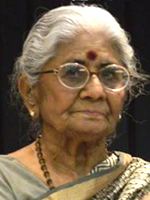
Bhandari is one of the post independence writers who portray women under a new light, as independent and intellectual individuals. Through the subject matter of her narratives, Bhandari highlights the struggles and difficulties women have constantly encountered in the past. Sexual, emotional, mental and economic exploitation had placed women in an extremely weak position in our society. Her female characters in her stories are portrayed as strong, independent individuals, breaking old habits and emerging and creating an image of 'new women'.
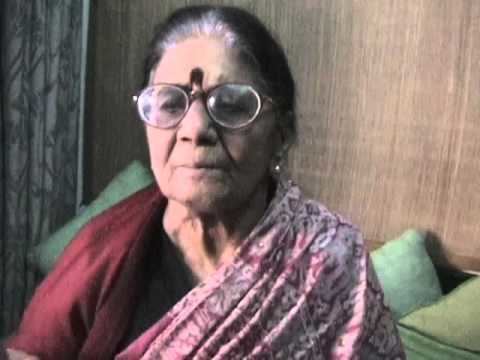
Biography
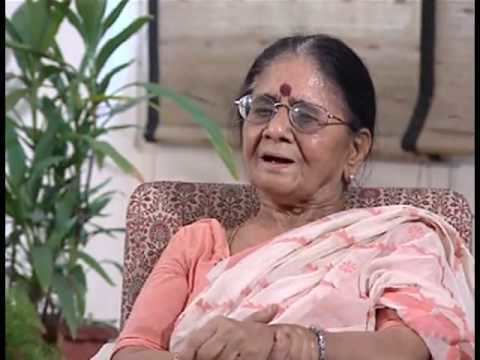
Bhandari was born on 3 April 1931, in Bhanpura, Madhya Pradesh and grew up largely in Ajmer, Rajasthan, where her father Sukhsampat Rai Bhandari, was a freedom fighter, social reformer and the producer of the first English to Hindi and English to Marathi dictionaries. She was the youngest of five children (two brothers, three sisters). She had her early education in Ajmer, graduated from Calcutta University and then went onto obtaining an M.A degree in Hindi language and literature, at Hindu Vishwavidyalaya, Varanasi. In 1946, she helped organize a strike in 1946 after two of her colleagues were dismissed for being involved with Subhash Chandra Bose's Indian National Army. She initially worked as a lecturer in Hindi in Calcutta, but subsequently returned to Delhi to teach Hindi literature at Miranda House College, in the University of Delhi.
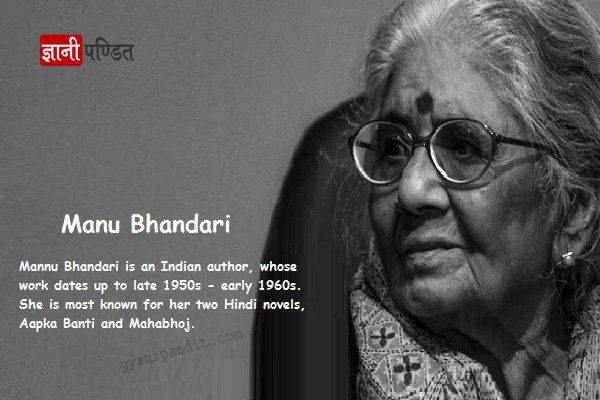
She is the wife of Hindi author and editor Rajendra Yadav.
Teaching

She began her career as a Hindi Professor. From 1952-1961 she taught at Kolkatta’s Baliganj Shiksha Sadan, 1961-1965 at Kolkata’s Rani Birla College, 1964-1991 at Miranda House College, Delhi University and from 1992-1994 she chaired the directorship at Ujjain’s Premchand Srijanpith, in Vikram University. In 2008, Bhandari was honoured with the Vyas Samman, instituted by the K K Birla Foundation for her autobiography Ek Kahaani Yeh Bhi. This award is given every year for outstanding literary achievements in Hindi.
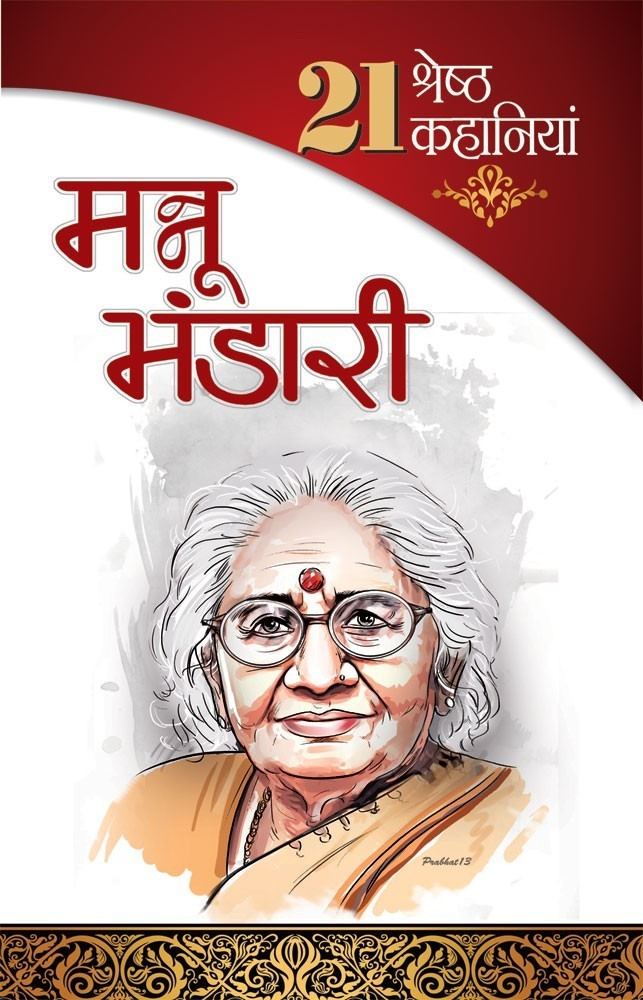
Her works reflect the changing moods of society, as they shape and mould her writing and subject matter. Modernism, prevailing social issues and transformations, contemporary social situations, daily struggles of an individual have all played a part in impacting and influencing Bhandari’s works.
Writing
Bhandari's first novel, Ek Inch Muskaan, was co-authored with her husband, the writer and editor Rajendra Yadav and was published in 1961. The story was initially conceived of by Bhandari, and involved a romance between a man and two women. Yadav contributed the title, and they wrote the dialogues for the male and female characters respectively.
She followed this with her first individually published piece of writing, a story titled Main Haar Gayi (I've Lost) in 1957. Her second novel, Aap Ka Bunty (Your Bunty) was a portrayal of the collapse of a marriage through the eyes of a child, the titular Bunty, whose parents ultimately underwent a divorce and remarried other people. The novel was published to great acclaim and has been described as a 'milestone and a turning point in Hindi literature' by the critic Anil Kumar Singh. It has been translated widely, including into French, Bengali, and English. This story was later adapted to a highly popular and successful play and was performed all over the nation, including at the (Bharat Rang Mahotsav) (National Theatre Festival), in New Delhi. In Yahi Sach Hai (This is Truth) Bhandari wrote about a woman attempting to choose between her lover, and her husband. Her novel, ‘Mahabhoj’ (1979) highlights the struggles and battles of a common man constantly getting sucked into the immense bureaucratic corruption that exists within society. Other stories and novels include Ek Plate Sailab (1962), Teen Nigahon Ki Ek Tasvir, Trishanku, and Aankhon Dekha Jhooth.
Bhandari, along with her husband, Rajendra Yadav, as well as other writers in Hindi, including Krishna Sobti, were key figures in the Hindi literary movement called Nayi Kahani (New Story). Their approach was focused real life experiences in opposition to the structured, romantic style of their predecessors.
Critic and writer R.S. Singh has noted on an assessment of Bhandari's oeuvre that her "...forte is the middle class woman seeking emancipation from social and moral conservatism in order to develop her personality on an equal footing with man's, and thus make her existence meaningfully significant." Her portrayal of female characters, use of irony, and symbolism, have won acclaim.
In addition to her own fiction, Bhandari has written screenplays for adaptations of two of her own works; for the film Rajnigandha (adapted from her story, Yahi Sach Hai) and Jeena Yahan. She also wrote the screenplay for the film Swami, which was based on a novel by Saratchandra Chattopadhyaya.
Bhandari is considered to be amongst the greatest Hindi storytellers of the 19th-20th century.
Translations and Adaptations
Bhandari's works have been translated into many Indian languages and some have been adapted into films as well as for the stage. The Hindi movie Rajnigandha (1974), which was based on her short story Yahi Sach Hai (यही सच है), won the Filmfare Best Movie Award in 1974.
Plays and fiction
Compilations of stories
Staged
Feature Films
Controversy concerning the film adaptation of Aap Ka Bunty
Bhandari sold the rights to her second novel, Aap Ka Bunty and it was subsequently adapted for a film produced by Dharmendra Goyal and directed by Sisir Mishra. The film, Samay ki Dhara, starred Shabana Azmi, Shatrughan Sinha, Tina Munim and Vinod Mehra. Bhandari subsequently sued the filmmakers, Kala Vikas Pictures Pvt Ltd, on the grounds that the adaptation distorted her novel and consequently violated Section 57 of the Indian Copyright Act, 1957. The judgment in this case, Manu Bhandari v. Kala Vikas Motion Pictures Ltd is a landmark decision in Indian copyright law that clarified the scope of an author's moral rights under Indian copyright law. The Court held in favour of Bhandari, but she and the producers ultimately arrived at a settlement out of court.
